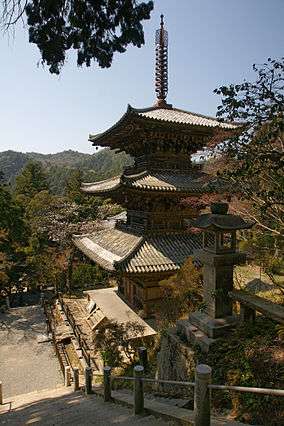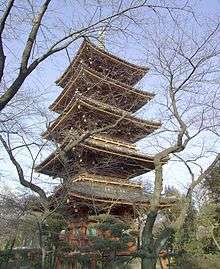Tenkai
| Part of a series on |
| Buddhism in Japan |
|---|
 |
Tenkai (天海 Tenkai, 1536 – 1643) was a Japanese Tendai Buddhist monk of the Azuchi-Momoyama and early Edo periods. He achieved the rank of Daisōjō, the highest rank of the priesthood. His Buddhist name was first Zuifū (随風), which he changed to Tenkai in 1590. Also known as Nankōbō Tenkai (南光坊 天海), he died in 1643, and was granted the posthumous title of Jigen Daishi (慈眼大師) in 1648.
Tenkai was at Kita-in (then written 北院) in Kawagoe in 1588, and became abbot in 1599. He was on the staff of Tokugawa Ieyasu, and served as a liaison between the Tokugawa Shogunate and the Imperial Court in Kyoto. One of his projects was the rebuilding of Enryaku-ji, which had been devastated by Oda Nobunaga. He also revitalized Kita-in, and changed the characters of its name to 喜多院. Nearing death in 1616, Ieyasu entrusted Tenkai with his last will regarding matters of his funeral and his posthumous name. Tenkai selected gongen rather than myōjin, and after death Ieyasu became known as Tōshō Daigongen.
Tenkai continued to serve as a consultant to the next two Tokugawa shoguns. In 1624, retired shogun Tokugawa Hidetada and ruling shogun Tokugawa Iemitsu asked him to establish Kan'ei-ji, a Buddhist temple to the northeast of Edo Castle in Ueno.
There are several theories concerning his early life. Some fiction writers postulate that he was in actuality Akechi Mitsuhide. It is not certain whether Mitsuhide died at the Battle of Yamazaki or not, and some suppose that he survived and began a new life as the priest Tenkai.
In popular media
- Tenkai appears as the main villain in the first Sakura Wars game.
- In the game Sengoku Basara 3 and the anime Sengoku Basara: The Last Party the character Tenkai is portrayed as a cryptic monk who speaks in riddles and wields twin scythes. As with the rumor above, Tenkai is actually a re-skinned model of Akechi Mitsuhide, from the game and anime's predecessor.
- In the Onimusha game series, Samanosuke Akechi took on the identity of Tenkai in Onimusha: Dawn of Dreams.
- He also appears in the spin-off of the Yakuza video game series' Ryū ga Gotoku Kenzan!.
- In the video game "Shin Megami Tensei IV" Tenkai appears as a National Defense Divinity once the party reaches a later portion of Tokyo.
Gallery
 Rule of Shimotsukie written by Tenkai
Rule of Shimotsukie written by Tenkai Tenkai established Kan'ei-ji in 1624
Tenkai established Kan'ei-ji in 1624 Tenkai's grave
Tenkai's grave Jigendo in Sakamoto, Otsu
Jigendo in Sakamoto, Otsu
References
- KITAIN site (English)
- みつめよう私たちの国土-東京都(か~せ) (IPA, an agency of the Government of Japan) (Japanese)
- (社)日光観光協会オフィシャルサイト (Japanese)